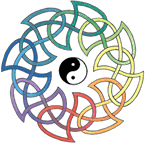
Walking Meditation Walking Quotations The Ways of Walking
This webpage is a work in progress. It
is my summer webpage project, starting on June 1, 2013.
Work will be completed by August 31, 2013. Please excuse the disjointed
and incomplete presentation.
Walking in a Sacred Circle
Introduction
I often "Walk in the Sacred Circle," with the primary intention of relating to the meanings and associations of the Eight Energies (Eight Elementals, Eight Dimensions, Eight Bagua Trigrams) symbolized in our backyard outdoor Sacred Circle Garden. This is a practice of quiet meditation; and, a place for working on the integration of mind/energy/spirit (Yi/Qi/Shen) by means of a physical practice, ritual, and use of the active imagination. There are also many bodily benefits of this practice: warming up and awakening the body, conditioning and strengthening the legs and cardio-vascular system, learning to maintain a relaxed and upright posture, breathing deeply and properly, improving balance, and enhancing general awareness and sensitivity. Just being outdoors has numerous benefits for the body, mind, and spirit.
To provide variety and to relate to the meanings and
symbolism of the Eight Elementals (Energies, Dimensions, Forces), I hold my
hands in different positions while walking the circle. I think that each
of these hand positions (i.e., mudras, symbolic hand positions, palm
postures) help bring mental focus on one of the eight essential
energies/dimensions of the cosmos, highlights those energies, and helps the mind
concentrate and focus more readily. The Heart-Mind-Spirit-Energies (Hsin-Shen-Qi)
Circle Walking ritual practice helps to build and circulate the vital energy,
Qi-Prana-Chi
or Life Force in the body/mind of the practitioner; and, repeated and
consistent work with this type of ritual exercise is Bagua
Qigong.
My decision as to how I view Walking in the Sacred Circle ritual practice is based on my interpretation of the Eight Energies and Eight Dimensions of the Cosmos. My interpretations are based upon my research into Daoism, Neo-Paganism, Druidry, shamanism, rituals, geomancy, Trigrams and I Ching, divination, nature mysticism, and styles of walking mediation; as well as practical experiments in these areas.
My wife, Karen, and I have constructed a "Sacred Circle Garden" (Nemeton Grove, Reflection Circle, Serenity Circle, Circular Sacred Garden, etc) which can be used for this kind of Heart-Mind-Spirit-Energies (Hsin-Shen-Qi) Circle Walking ritual and meditation practice as well as for other ritual, magickal, mystical, seasonal, outdoor relaxation, and celebratory activities.
Adults and Children, Hawks, Owls, Birds, Cats, Dogs, Lizards, Snakes, Toads, Bats, Raccoons, Insects and other Critters have visited our Sacred Circle Garden thus far. We welcome all Fairies, Elves, Unicorns, Dragons, Phoenixes, Spirits, Guardians of the Four Directions, Gods and Goddesses, and Wee Folk to our Sacred Circle and we leave offerings of food, water, gifts, and incense to welcome all of them. We would get very unnerved if a real Lion or Bear appeared in the Nemeton while we were present; but we do hope that they are thriving somewhere else in the Wild on this planet. We live in a rural area near Red Bluff, California, in the Northern Hemisphere.
Consider Wang Shujin's Baguazhang advice that, "The
definitions above are just rough explanations of a much larger picture. As for
the details, it depends upon the learner himself to study, question, consider,
analyze, and practice in order to find deeper meaning. The eight forms should
also be examined and practiced individually. In conclusion, the more diligently
you study the greater your return. Bagua Zhang forms imitate the nature of
heaven and earth. Follow the principles of yin-yang and harmonize with the
seasons, and you will benefit humanity by developing a more universal view of
life. Embracing the yin-yang fish and treading the ba gua diagram you will
walk the circle as though striding through the cosmos."
- Wang Shujin, Bagua Linked Palms, Translated by Kent Howard, 2009
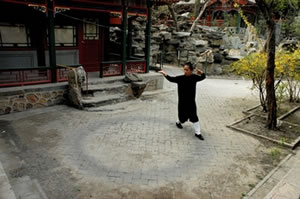
A Daoist monk at the Baiyunguan temple in
Beijing
practices his
Bagua stepping
in one of the many courtyards tucked away in the compound.
My research into related topics are all published in my blog or on webpages
on the Internet:
Bagua Zhang (Pa Kua Chang): Bibliography, Links, Resources, Quotes, Lessons
Ripening Peaches: Daoist Studies and Practices
Months of the Year: Poems, Quotations, Wisdom, Lore
Sixty-Four Elements of the Backyard Cosmos
Study with Mike Garofalo in Red Bluff, California
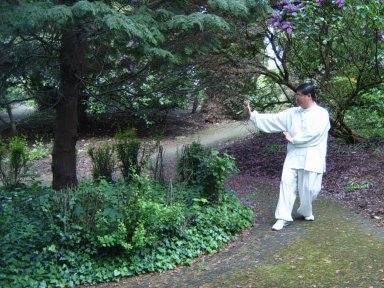
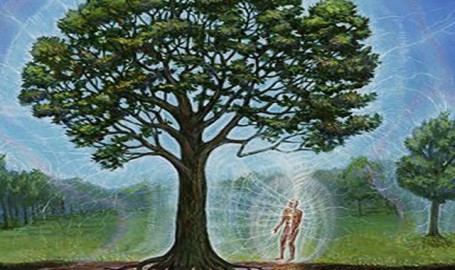
Meditative walking around a tree in a garden.
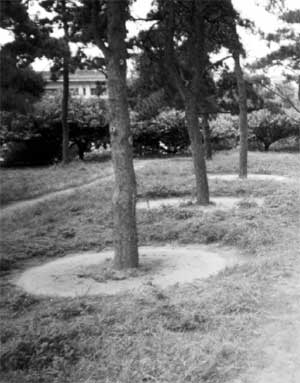
Bagua circles around trees in Beijing's Temple of Heaven Park
Walking in a Sacred Circle Garden
A Walking Meditation Routine by Mike
Garofalo
Instructions
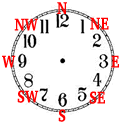
Sacred Circle Walking Preparation
1. The Sacred Circle walking path should be cleared of all chairs, tables,
benches, or other obstacles. The center ring of our Sacred Circle is about
18 feet in diameter. The earth in the center ring of our Sacred Circle is
hard packed clay dirt.
2. The candle and incense on the center white altar should be ceremoniously lighted. In the center of our Sacred Circle is a round red brick fireplace, about 3 feet in diameter.
3. An offering should be placed in the offering bowl on the center white altar.
4. Open the Four Gates (Casting the Circle) appropriately from the center position at the white altar.
5. Face (N12) the North Green Pole, in the walking path, and stand quietly in the Wuji posture.
6. Open arms out to side and up to touch both hands over my head. Draw both arms down to waist, and assume position #1: The Unicorn Emerges from the Canyon into the Moonlight.
In Ba Gua Zhang circle walking mind/body arts and practices, these Eight Postures are sometimes called the "Ding Shi" Postures.
Study with Mike Garofalo in Red Bluff, California
1. The Unicorn Emerges from the Canyon in the Moonlight
2. The Green Dragon Stretches Out Its Claws at Dawn
3. The Hawk Streaks Across the Clear Morning Sky
4. The Monkey King Offers the Early Fruits
First Sacred Circle Walking Posture
1. The Unicorn Emerges from the Canyon in the Moonlight
Qilin (Unicorn, Lin,
Chilin) Gentle Herbivore, Earth: Kun, Body, Physical World, Winter,
North, Receptivity, Night, Darkness, Moon, Midnight. A Qilin
(Unicorn) appears at the birth of a person who will become a Sage.
Yin-Yin, Green North
Pole, 12-3 am, Birth & Childhood: Ages ?-0-10.
K'un,
Earth,
North,
Winter,
土 ,
![]()
The Chilin Pushes Down to the Earth [Zhang 2008, p.140]
(Key to all the Reference Sources)
Fierce Tiger Comes Out of the Mountain [Allen/Zhang 2007, p.75,
p.227]
Downward Sinking Palm (Xia Chen Zhang) [Gao/Bisio 2007, p.
124]
Qi Still and Step on the Earth - Charging the Tan Tien Qi [Bracy 1998,
p.66]
Preparation Posture [Liang/Yang 1994 and Wu Ji]
The Unicorn Emerges From the Canyon in the Moonlight [Garofalo 2006]
Movement Steps:
I begin by standing, facing N12 towards the Green North Pole, opening bagua zhang style, turning to face S6, taking the first "The Unicorn Emerges from the Canyon into the Moonlight #1" posture. Then I step out with the left foot to begin walking, bagua zhang mud step style, in a counter-clockwise direction (N12, W9, S6, E3, N12).
My waist is turned towards the Center of the Circle. The center of my walking circle is a round brick fireplace, 3 feet in diameter. I walk along the edge of a circle that is from 4 to 8 feet in diameter. I walk on hard clay dirt.
When I get to N12, I turn, bagua zhang single palm change style, reverse my direction, and walk clockwise (N12, E3, 6S, W9). I stop at the NE 1.5 Position in front of the Lime Green Northeast Pole, turn, take The Green Dragon Strectches Out Its Claws at Dawn #2 posture, then proceed to walk the circle again.
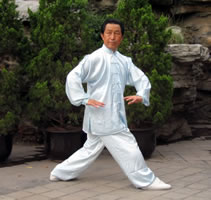
"This pure yin, all-female energy sinks downward, soft and heavy, while
drawing inward. It is a receptive energy, which nurtures the energy of
Heaven and brings manifestation from the creative potential of pure yang.
This energy-change pattern can be compared to the sexuality of an ancient
earth-mother symbol, such as the Venus of Willendorf. The Earth
energy-change pattern corresponds to the physicality of the various double palm
changes with the vast variety of ba gua zhang styles."
- Frank Allen and Tina Chunna Zhang, The Whirling Circles of Ba Gua
Zhang, 2007, p. 228
"Song of the Downward Sinking Palm: Hold in the chest, keep the upper back
erect, and sink the lower back. Twist the hip, close the knees, and grasp
the ground tightly. Inhale in lifting, exhale in extending and uplifting
the head. Relax the shoulders and stretch the elbow for downward-sinking
palm."
- Gao Ji Wu and Tom Bisio, The Essentials of Ba Gua Zhang, 2007, p.
124.
Second Sacred Circle Walking Posture
2. The Green Dragon Stretches Out Its Claws at Dawn
Chinese Dragon, Thunder: Zhen, Rain, Winter-Spring, Northeast, Lime Green Northeast Pole, Early Morning and Daybreak, 3-6 am, Ages 10-20.
Chen, Zhen, Thunder,
Green
Dragon Stretches Its Claws [Allen/Zhang 2007, p. 77], and the
Windmill Posture.
Millstone Pushing Palm (Tui Mo Zhang) [Gao 2007, p. 145]
The Green Dragon Stretches Out Its Claws
at Dawn [Garofalo 2006]
Third Sacred Circle Walking Posture
3. The Hawk Streaks Across the Clear Morning Sky
Hawk (Rooster or Owl), Air, Fire: Li, Spring, East, Yang-Yin, Mind-Intellect, Sword, Knowledge, Morning, Yellow East Pole, 6-9 am, Ages 20-30.
Li, Fire, Spring, East, 火,Lion Opens Its Mouth
[Allen/Zhang 2007]
Young Man Shoulders the Mountain [Bracy 1998]
Push Mill Posture [Liang/Yang 1994]
The Hawk Streaks Across the Clear Morning Sky [Garofalo 2006]
Fourth Sacred Circle Walking Posture
4. The Monkey King Offers the Early Fruits
Monkey, Monkey King: Sun Wukong, Lake/Wet Valley: Dui, Spring-Summer, Southeast, Orange Southeast Pole, 9-12 am, Ages 30-40.
Tui, Lake, Valley, Irrigated Field,
White Ape Presents the Peach
[Allen/Zhang 2007, p.76]
Embrace the Moon - Turning the Joints Outward [Bracy,
1998]
Rotate Palm Posture [Liang/Wang, 1994]
The Monkey King Offers the Early Fruits
[Garofalo 2006]
Fifth Sacred Circle Walking Posture
5. The Fierce Lion Leaps Out in the Summer Sun
Lion (Tiger, Cat, Wolf/Dog) Carnivorous Predator, Heaven: Qian, Will, Forceful Power, Summer, South, Yang-Yang, Fire, Wood, Noonday, Sun, Red South Pole, 12-3 pm, Ages 40-50.
Embrace the Moon
[Allen/Zhang, 2007]
Bear Lifts Roof [Bracy, 1998]
Spiral and Rotate Posture [Liang/Wang, 1994]
The Fierce Lion Leaps Out in the Summer Sun [Garofalo
2006]
6. The Phoenix Appears at
the Harvest Festival in Peaceful Times
Fenghuang: Chinese
Phoenix, Wind: Xun, Summer-Autumn, Harvest Time, Southwest, Purple
Southwest Pole,
Afternoon, 3-6 pm,
Ages 50-60.
Sixth Mind-Energy Circle Walking or Bagua Qigong Practice
Black Bear Stretches Out Its Paw
[Allen/Zhang, 2007]
Lion Holds Ball [Bracy, 1998]
Twist Turning Posture [Liang/Wang, 1994]
The Phoenix Appears at the Harvest Festival in Peaceful Times [Garofalo 2006]
7. The White Snake Becomes a Beautiful Lady
at Dusk
Snake, Water:
Kan, Autumn, West, Yin-Yang, Emotions-Feelings, The Well, Blue West Pole,
Sunset and Evening, 6-9 pm, Ages 60-70.
Legend of
Madame White Snake.
Seventh Mind-Energy Circle Walking or Bagua Qigong Practice
Pointing to Heaven and Plunging
to Earth [Allen/Zhang, 2007]
Lotus Palm [Bracy, 1998]
Bore and Turn Posture [Liang/Wang, 1994]
The White Snake Becomes a Beautiful Lady at Dusk [Garofalo 2006]
8.
The Bear Enters Her Den to Hibernate
Bear, Mountain:
Gen, Autumn-Winter, Northwest, Metal, Turquoise Northwest Pole, Night, 9-12
pm, Old Age: 70-Death-?.
Identical to the
basic Bear Posture in the Yin Style of Bagua, as presented by Xie Peiqui and He
Jinbao.
Eight Mind-Energy Circle Walking or Bagua Qigong Practice
Green Dragon Stretches Its Claws
[Allen/Zhang, 2007]
Acquire the Heart Palm [Bracy,
1998]
Closing Gong Posture [Liang/Yang, 1994]
The Bear Enters Her Den to Hibernate [Garofalo
2006]
Most Bagua Zhang books and instructional media offer some suggestions as to practices for beginners in Circle Walking, Bagua Qigong, Warming Up Routines, or Zhan Zhuang (Standing Meditation). These suggested practices vary quite a bit as to specifics from teacher to teacher, although the purposes or intentions of such activities are often similar: warming up, simple walking practice, qigong. I have developed my own routine/ritual for home practice in our Sacred Circle called Mind-Energy (Yi-Qi) Bagua Zhang Circle Walking. Here are some of the other suggestions that I have learned about and borrowed from:
General Warm Up and/or Qigong Routines:
Universal Standing Post and Yi Quan Practices [Wang Shujin 1978]
Sixteen Zhan Zhuang Exercises [Zhang Jie 2008]
Eight Section Brocade
Some of the Five Animal Frolics
Stretching
counter-clockwise back (N12, W9, S6, to NE 1.5), turn, return clockwise to E3 in front of the Yellow East Pole, turn, take the Owl #3 posture, and walk back counter-clockwise. This pattern continues with stops at each Pole and changing to the Animal Posture for that position (Unicorn N #1, Dragon NE # 2, Hawk E #3, Monkey SE #4, Lion S #5, Phoenix SW #6, Snake W #7, Bear NW #8). I walk around the circle 2 times (counter-clockwise and clockwise) for each of the Eight Animals.
I end at N12, turn to face S6 and hold for a good while in a San Ti Shi, Embrace the One, or some another standing meditation posture.
Reference Sources for this Sacred Circle Walking Practice
Allen 2007
The
Whirling Circles of Ba Gua Zhang: The Art and Legends of the Eight Trigram
Palm. By Frank Allen and
Tina Chunna Zhang. Berkeley, California,
Blue Snake Books, 2007. 238 pages. Illustrated with black and white
photos. ISBN: 1583941894. Eight Palm Postures Circle Walking is
described on pages
74-82. VSCL.
Bracy 1998 Ba Gua: Hidden Knowledge in the Taoist Internal Martial Art. By
John Bracy
and Liu Xing-Han. The Bagua Qigong set is described on
pages 65-74. All exercises in this set are done while walking the circle. Only one
photograph
for each exercise is provided. VSCL.
Garofalo 2006
Walking in a Sacred
Circle Garden by Michael P. Garofalo, 2006. Red Bluff, California,
Valley Spirit Center,
Green Way Research.
Liang 1994: Baguazhang (Emei Baguazhang): Theory and Applications. By Liang,
Master
Shou-Yu, and Wu, Wen-Ching, and Yang, Jwing-Ming.
The "Bagua Turning-Spinning Qigong," is found on pp. 36-151. The
qigong
instructions Include detailed descriptions, multiple photographs for each exercise, and translations of Chinese texts. Only the last exercise
in this
set is done while walking the circle. VSTLC.
Wang Shujin, according to all reports, had all
his Bagua Zhang, Hsing I Quan, and Tajiiquan students practice
Zhan Zhuang (Standing Meditaton) at the beginning of all
training sessions. Most internal martial arts masters strongly recommend
Zhan Zhuang practice.
Bagua
Linked Palms. By Wang Shujin (1904-1981). Translated by
Kent Howard
and Hsiao-Yen Chen. Blue Snake Books, 2009. First Edition in
Chinese, 1978. 250 pages. ISBN:
1583942645.
Zhang 2008
Liu
Bin's Zhuang Gong Bagua Zhang: Foundation Practices, Volume One. South
District Beijing's Strongly Rooted Style. By Zhang, Jie. Contributions by Richard Shapiro. Blue Snake Books, 2008.
Glossary, xxix, 232 pages. ISBN: 1583942181. Sixteen Zhan Zhuang
Exercises, pp. 109-132.
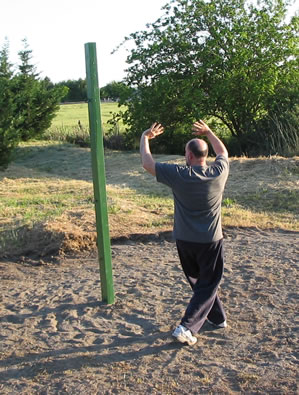
"Embrace the Moon" (Bracey & Allen/Zhang) Baguazhang Qigong Posture
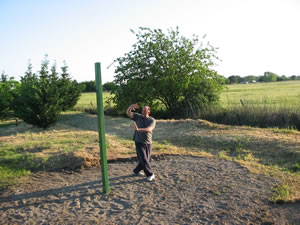
"Acquire the Heart Palm" Baguazhang Qigong Posture
Walking in the
Sacred Circle
Bibliography, Links, Resources
Ba Gua Circle Walking Nei Gong: The Meridian Opening Palms of Ba Gua Zhang.
By Tom Bisio. Denver, Colorado, Outskirts Press, 2012. Bibliography,
249 pages. ISBN:
978-1432796891. VSCL.
Ba Gua: Hidden Knowledge in the Taoist Internal Martial Art.
By John Bracy
and Liu Xing-Han. Consulting editors: Li Zhong-Quan and Liu Men-Gen,
Beijing, China. Berkeley, California, North Atlantic Books, 1998.
Index,
bibliography, notes, 139 pages. ISBN: 1556432763. VSCL.
Baguazhang: Emei Baguazhang Theory and Applications.
By Liang,
Shou-Yu, and Wu, Wen-Ching, and Yang, Jwing-Ming. YMAA Publication Center,
1994. 364 pages. ISBN: 0940871300. VSCL.
Combat Techniques of Taiji, Xingyi, and Bagua: Principles and Practices of Internal Martial Arts. By Lu Shengli. Translated and Edited by Zhang Yun and
Susan Darley. Berkeley, California, Blue Snake Books, 2006. 369 pages.
ISBN:9583941452. General history and principles of 3 internal arts, basic movements, basic
gongfu
training techniques, and a detailed description with photographs of the
Sixteen-Posture
form (pp. 231-356). VSCL.
Eight Mother Palms Practice, UTube, Sifu Novell
Eight Mother Palms of Nine Dragon Baguazhang
The Essentials of Ba Gua Zhang.
By Gao Ji Wu and Tom Bisio. New York, Trip Tych
Enterprises, 2007. 570
photographs by Valerie Ghent. 358 pages. ISBN: 9780979158803.
VSCL.
Learning Bagua Zhang: The Martial Art of Change.
By Ted Mancuso. Santa Cruz, California, Plum Publications, 2012. 225 pages. ISBN:
978-0979015984. VSCL.
Liu Bin's Zhuang Gong Bagua Zhang, Volume One: South District Beijing's Strongly Rooted Style.
By Zhang, Jie. Contributions by Richard Shapiro. Blue Snake Books, 2008.
Glossary, xxix, 232 pages. ISBN: 1583942181. VSCL.
Pa-Kua: Chinese Boxing for Fitness & Self-Defense.
By Robert K.
Smith. Berkeley, California, North Atlantic Books, 2003. Originally published in 1967, Tokyo. 160 pages.
ISBN: 1556434391. Sun Lu Tang's Circle Walking form on pp. 113-160.
VSCL.
Sacred Circles.
By Michael P. Garofalo, Valley Spirit Taijiquan. 133Kb.
Study with Mike Garofalo in Red Bluff,
California
Ways of Walking
By Michael P. Garofalo.
Walking Meditation.
By Michael P. Garofalo.
The Whirling Circles of Ba Gua Zhang: The Art and Legends of the Eight Trigram Palm. By Frank Allen and
Tina Chunna Zhang.
Berkeley, California, Blue Snake Books, 2007. 238 pages. Illustrated
with black and white photos. ISBN: 1583941894. VSCL.
Bagua Zhang (Pa Kua
Chang): Bibliography, Links, Resources, Quotes, Lessons By
Michael P. Garofalo, Valley Spirit Taijiquan. 195Kb.
One Old Druid's Journey
By Michael P. Garofalo, Green Way Research. 500Kb
Months of the Year:
Poems, Quotations, Wisdom, Lore By Michael P. Garofalo,
Green Way Research. 1.5MB
The
Psychology of Ritual. By Murry Hope. London, Element Books,
1988. Appendics, glossary, index, 310 pages. ISBN: 1852300434.
VSTLC.
Ripening Peaches: Daoist
Studies and Practices
Sixty-Four Elements of the
Backyard Cosmos
Valley Spirit Center:
Taijiquan, Qigong, Yoga, Walking. Instructor: Mike Garofalo.
VSCL = Valley Spirit Center Library, Red Bluff, California
Here are four Baguazhang learning resources I have found to be very useful:
Ba Gua: Hidden Knowledge in the Taoist Internal Martial Art.
By John Bracy
and Liu Xing-Han. Consulting editors: Li Zhong-Quan and Liu Men-Gen,
Beijing, China. Berkeley, California, North Atlantic Books, 1998.
Index,
bibliography, notes, 139 pages. ISBN: 1556432763. VSCL.
The Whirling Circles of Ba Gua Zhang: The Art and Legends of the Eight Trigram Palm. By Frank Allen and
Tina Chunna Zhang.
Berkeley, California, Blue Snake Books, 2007. 238 pages. Illustrated
with black and white photos. ISBN: 1583941894.
Learning Bagua Zhang: The Martial Art of Change.
By Ted Mancuso. Santa Cruz, California, Plum Publications, 2012. 225 pages. ISBN:
978-0979015984. VSCL.

|
|
||||
|
|
Eastern |
Five Elements |
Western |
Daily Cycle
|
|
North Green Earth Winter Body Oaks |
K'un Earth North Winter 土
|
Earth Center Yellow Dragon Spleen, Smell Mother Valley Spirit |
Body, Flesh, Beings Sensations Touch Earth, Soil, Stone Birth and Death Night New Moon Pentacle, Coins North Winter Trees and Shrubs Salt Oak Trees |
Midnight 12 am - 3 am
Conception to Birth
Birth and Death |
|
Northeast Lime Green Cypresses |
Chen Thunder |
Wood East Blue Dragon Liver, Sight Oldest Brother |
Early Morning Sunrise 3am - 6am 10 to 20 Years Old
|
|
|
East Yellow Air Birds Spring Mind Spirit Olives
|
Li Fire Spring East 火
|
Fire South Red Phoenix Heart, Sound Second Son |
Mind Thinking Air Smell Metal, Swords Childhood and Youth Dawn Crescent Moon Spring East Incense, Bells Olives, Aspens |
Morning 6am - 9am
20 to 30 Years Old |
|
Southeast Orange Bottlebrush |
Tui Lake Valley Irrigated Field
|
Metal, Lake West White Tiger Lung, Taste First Son |
Mid-Morning 30 to 40 Years Old
|
|
|
South |
Chien |
Metal, Sky West White Tiger Lung, Taste Father |
Will, Spirit Intuition Wood Fire Sight South Adult and Middle Age Midday Summer Full Moon Staff, Stave Red Candle Almonds Walnuts
|
Noon 12 pm - 3pm 40 to 50 Years Old |
|
Southwest Purple Redwoods |
Sun Wind |
Wood East Blue Dragon Liver, Sight Oldest Sister |
Afternoon 3pm - 6 pm 50 to 60 Years Old |
|
|
West Blue Water Autumn Emotions |
K'an Water West Autumn 水
|
Water North Black Tortoise Kidney, Touch Second Daughter |
Emotions, Blood Feelings Water, Cups Taste Middle and Old Age Evening Waning Moon West Autumn Cauldron, Chalice Willows, Laurels |
Late Afternoon Sunset 6 pm - 9pm
60 to 70 Years Old |
| Inner Entrance | ||||
|
Northwest Turquoise Liquid Ambers |
Ken Mountain |
Earth Center Yellow Dragon Spleen. Smell First Daughter |
Evening 9pm - 12 pm
70 to 80+ Years Old
|
|
|
Center |
Tai Chi Grant Ultimate |
Wholeness Harmony Interdependence Individual Self Circle Web White - All Colors |
||
|
|
||||
|
|
Western |
Daily Cycle
|
Annual Cycle
|
Deities
|
|
North Green Earth Winter Body Oaks |
Body, Flesh, Beings Sensations Touch Earth, Soil, Stone Birth and Death Night New Moon Pentacle, Coins North Winter Trees and Shrubs Salt Oak Trees |
Midnight 12 am - 3 am
Conception to Birth
Birth and Death |
December 21st - March 19th Yule New Year Christmas |
Goddess Mother Ceres Demeter Gaea, Rhea Dionysos Pan Gnomes |
|
Northeast Lime Green Cypresses |
Early Morning Sunrise 3am - 6am 10 to 20 Years Old
|
February 2nd - March19th Imbolic Chinese New Year |
||
|
East Yellow Air Spring Mind Spirit Olives
|
Mind Thinking Air Smell Metal, Swords Childhood and Youth Dawn Crescent Moon Spring East Incense, Bells Olives, Aspens |
Morning 6am - 9am
20 to 30 Years Old |
March 20th - June 20th Spring Equinox, Ostara Memorial Day |
Son Aradia Athena Minerva Hermes Zeus Sylphs |
|
Southeast Orange Bottlebrush |
Mid-Morning 30 to 40 Years Old
|
May 1st - June 20th Beltane |
||
|
South |
Will, Spirit Intuition Wood Fire Sight South Adult and Middle Age Midday Summer Full Moon Staff, Stave Red Candle Almonds Walnuts
|
Noon 12 pm - 3pm 40 to 50 Years Old |
June 21st - September 21st Summer Solstice Lithia Labor Day |
Father Hestia Vesta Horus Vulcan Salamanders |
|
Southwest Purple Redwoods |
Afternoon 3pm - 6 pm 50 to 60 Years Old |
L
August 1st - September
21st |
||
|
West Blue Water Autumn Emotions Evergreen Shrubs |
Emotions, Blood Feelings Water, Cups Taste Middle and Old Age Evening Waning Moon West Autumn Cauldron, Chalice Willows, Laurels |
Late Afternoon Sunset 6 pm - 9pm
60 to 70 Years Old |
September 22nd - December 20th Autumnal Equinox Mabon |
Daughter Aphrodite Poseidon Neptune Undines |
|
Northwest Turquoise Liquid Ambers |
Evening 9pm - 12 pm
70 to 80+ Years Old
|
October 31st - December 20th Halloween Samhain Thanksgiving |
||
|
Center |
Wholeness Harmony Interdependence Individual Self Circle Web White - All Colors |
Year Annual Cycle A Human Life |
||
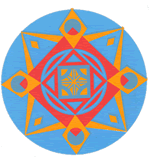
Walking in a Sacred Circle Garden
Quotations
"The eight "mother palms" (also called the
"nei gong" palms or the "qi gong" palms) are the foundational static upper body
postures which are held while the practitioner is practicing the circle walk.
These postures are designed to train certain structural alignments while the
practitioner is walking the circle. The upper body is held static while the
lower body is continuously moving. In the practice of holding the eight mother
palms the practitioner trains structural strengths, internal body connections,
internal/external body integration and harmony, development and awareness of
muscle groups not usually under conscious control, tendon strength and
conditioning, and joint opening and suppleness, in each of the eight postures
that are held. Again, the exact postures will vary from one Ba Gua system to the
next, each system of Ba Gua will have their own version of the "eight mother"
palms."
-
Pa Kau Chang Journal
"Without going on at length here are some
of the training methods connected to the Mother Palms (Eight Big Palms, Old
Palms): Dispelling toxins from the body, strengthening certain internal organs,
strengthening the arms, opening the chest and exercising the waist, key
elemental actions for fighting, preparation for weapons work, divorcing the
torso from the steps, bridging between standing practice and the later Palm
Changes, introducing all the elements which will be used in the Changes,
developing the essential bI-dimensional thinking, feeling animal qualities,
training the mind to control the body through "intent." Mother Palms are often
associated with the Eight Original Trigrams. They are performed in a circle but
while the arms don't move much they do engage and disengage."
- Ted Mancuso,
Ba Gua Zhang
"Mother Palms are
a dynamic kind of Qigong (life-force practice)
practiced in baguazhang (eight trigram palms) that open, build and restore the
energy channels within the body, as one walks in a circle. There are eight basic
upper body postures or shapes that are held while walking through the different
circular patterns and directions, and each shape can be held for various lengths
of time, which transition smoothly from one shape to the next without breaking
the flow. Ba Mu Zhang or Eight Mother Palms are designed to primarily train the
body's small muscle groups, tendons and soft tissues (such as the ligament,
joints, and fasciae) to maintain proper bone alignment and posture; this is one
of the core training methods practiced in the internal martial arts for
developing martial skill and whole body power. Additionally, variations on these
eight basic forms and or energy themes can also be practiced, with an emphasis
on connecting the different palm shapes to each other and maintaining consistent
energy flow to all parts of the body."
-
Ba Mu Zhang
"In bagua, the fighting tactics, anatomy,
and esoteric teachings are organized into the same octagon, with eight hand
movements, the Mu Zhang (“Mother Palms”), corresponding to the eight phenomena.
These “palms” are blended into a series of movements done while walking around a
circle. There is a divergence of teaching on how the Mother Palms are performed.
Some lineages turn their body and go the other way around the circle when they
do a Mother Palm, while others change palms without changing directions. Still
others teach the Mother Palms with arms held in static positions while walking
the circle."
-
Allen Pittman, Single Palm Change
"The definitions above are just rough
explanations of a much larger picture. As for the details, it depends upon the
learner himself to study, question, consider, analyze, and practice in order to
find deeper meaning. The eight forms should also be examined and practiced
individually. In conclusion, the more diligently you study the greater your
return. Bagua Zhang forms imitate the nature of heaven and earth. Follow the
principles of yin-yang and harmonize with the seasons, and you will benefit
humanity by developing a more universal view of life. Embracing the
yin-yang fish and treading the ba gua diagram you will walk the circle as though
striding through the cosmos."
- Wang Shujin, Bagua Linked Palms, Translated by Kent Howard, 2009
"It is surely to the shaman that all ritual owes the
concept of role-playing, or the temporary assumption of the nature of the
divinity whose good offices are being sought through the energies of the rite.
Role-playing in ritual is, of course, an integral part of sympathetic magic,
although many may not see it this way. Psychologically, it evokes the
particular aspect of the representative god-essence within the self. In
other words, by undertaking, for example, the role of Nephthys in an Egyptian
Rite, the player is search for correspondences hidden deeply with his or her own
subconscious, and submitting the appropriate archetypal figure for conscious
scrutiny by both the self and the group."
- Murray Hope, The Psychology of Ritual, p. 28
"The Quan Zhen (Complete Truth)
sect of Daoism was part of the Long Men (Dragon Gate) school of Daoism
which was originated by Qiu Chang Chun. Interestingly enough, Qiu also
invented a method of meditation whereby the practitioner would walk in a circle
and, wouldn't you know, this method was practiced by the Quan Zhen sect.
Delving further into this Daoist connection, Professor Kang Ge Wu was able to
find a section in the Daoist Canon which reads:
This bit of evidence inspired Professor Kang to try and find out more about
the circle walk meditation method practiced by the Quan Zhen Daoists.
What he discovered was that this practice, which the Daoists called Zhuan
Tian Zun (Rotating in Worship of Heaven) is very similar in principle to
the circle walk practice of Ba Gua Zhang. Researching Wang Jun Bao's book,
Daoist Method of Walking the Circle, Professor Kang found that while
walking, the Daoists repeated one of two mantras. The first of these mantras was
used in the morning practice and translates to mean "When Rotating in Worship of
Heaven, the sound of thunder is everywhere and transforms everything." The
second mantra was used in the evening practice and translates to mean "When
Rotating in Worship of Heaven, the great void saves us from the hardship of
existence." It was said that the practitioner should repeat the mantra with each
movement in the circle walk practice so that "one replaces one's myriad thoughts
with a single thought in order to calm and ease one's mind." The Daoists said
that in walking the circle the body's movements should be unified and the
practitioner strives for "stillness in motion." This practice was described as a
method of "training the body while harnessing the spirit."
"A person's heart and mind are in chaos.
Concentration on one thing makes the mind pure.
If one aspires to reach the Dao, one should practice walking
in a circle."
When instructing his students Dong Hai Chuan was noted as saying, "Training
martial arts ceaselessly is inferior to walking the circle. In Ba Gua Zhang the
circle walk practice is the font of all training." Ba Gua Zhang instructors
instruct their students to walk the circle with the spirit, Qi, intent,
and power concentrated on a single goal. This is similar to the Daoist method
whereby one clears the mind with a single thought. Although Ba Gua Zhang's
circle walk practice trains footwork to be used in fighting, it also shares the
Daoist's goals of creating stillness in motion and developing the body
internally."
- Dan Miller,
Pa Kua Chang Journal, Origins of the Circle Walk Practice in Ba Gua Zhang
Valley Spirit Center Taijiquan
Red Bluff, Tehama County, North Sacramento Valley, Northern California, U.S.A.
Cities and small towns in the area: Oroville, Paradise, Durham, Chico, Hamilton
City,
Corning, Rancho Tehama, Los Molinos, Vina, Tehama, Proberta, Gerber,
Manton, Cottonwood, Olinda, Cloverdale, Dairyville, Bend, Centerville, Summit
City
Anderson, Shasta Lake, Palo Cedro, Igo, Ono, Redding, Shasta, Colusa, Willows,
Richfield, Fall River, Montgomery Creek, Alturas, McCloud, Dunsmuir, Yreka,
Happy Camp,
Shingletown, Burney, Mt. Shasta City, Weaverville, Williams, Chester, Orland,
Susanville, Weed, Gridley, Marysville, Yuba City, NorCalifia, CA, California.
© Michael P. Garofalo, 2008-2013, All Rights Reserved
This webpage was last modified or updated on
June 6, 2013.
This webpage as first published on line on March 10, 2008.
Study with Mike Garofalo in Red Bluff, California
Qigong: Links and Bibliography
Cloud Hands: T'ai Chi Ch'uan and Chi Kung Website
Chen Style Taijiquan and Qigong
Valley Spirit Taijiquan, Red Bluff, California
Detailed Index to the Cloud Hands Website
Eight Trigrams Boxing, Palm
Boxing, Eight Diagrams Boxing
PaQua, Pa Kua, Pakuachang, Pa Kua Chang, PaKua Ch'uan, Pat Kwa Ch'uan
Baguaquan, Ba Kua Ch'uan, Ba Qua, Bagua, Ba Gwa, BaGua, Ba Gua Quan, Ba-qua,
Tai Chi Chuan, Taijiquan, T'ai Chi Ch'uan, Tai Chi, Tai Ji Quan, Taiji, Tai Ji
Chuan, Tie Jee Chewan
Chi Kung, Qi Gong, Qigong, Chee Gung, Qi, Chi, Tu Na, Dao Yin, Yi, Neigong,
GongFu, Kung Fu
Vacation and Learn in Beautiful Red Bluff, California
Beginning T'ai Chi Ch'uan Options: Yang 24, Chen 18, Sun 24, Cane 18
Beginning Chi Kung (Qigong) Options: Five Animal Frolics, Eight Brocades , Daoist Temple, Magic Pearl, Yoga
Lectures, Private Lessons,
Classes, Consulting, Workshops, Questions and Answers
Reasonable Hourly Rates
Instructor: Michael P. Garofalo, M.S.
Excellent Recreational Opportunities
for Persons of All Ages in the North Sacramento Valley
The Perfect Weekend Getaway for You, Friends and Family
Beautiful Scenery, Pleasant Weather, and Clear Skies for the Outdoor Enthusiast
Activities:
Sight Seeing, Walking, Shopping, Spas, Reading, Relaxing, Internal
Arts Studies
The Valley Spirit Center includes extensive gardens
for Tai Chi practice and a Sacred
Circle
A Full Array of Services and Excellent Accommodations in
Redding or
Red Bluff
Contact Mike: Email or Phone 530-200-3546
My Daily Tai Chi Chuan and Chi Kung Training Program